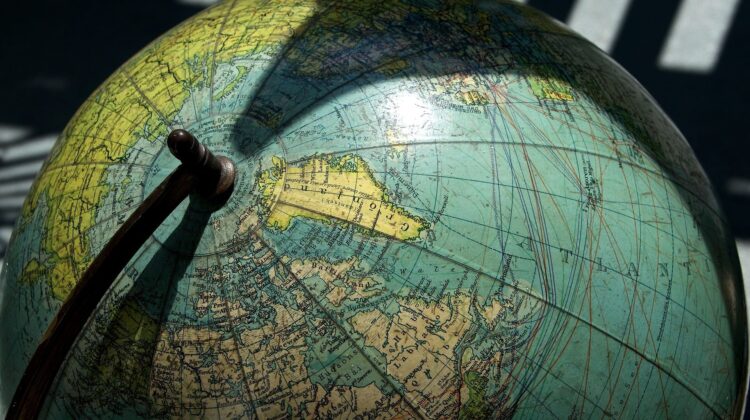
Did Climate Change Kill This Greenlander 70 Years Ago?
In 1952, a landslide caused a tsunami that killed a Greenlandic man. Some researchers think he might have been an early victim of anthropogenic warming.
On a vast shoreline of crumbled, sloping rock in central West Greenland, four fishermen are hard at work tending their nets. Barely an instant after they realize a wave is heading their way, it is upon them. The wave barrels into the barge they are standing on, lifting one end and throwing the men clear of the vessel. Blocks of ice flung skyward by the angry sea rain down. One man is hit in the mouth, he spits blood. Another takes a blow to the head.
Reeling, three of the fishermen manage to find each other. They spot their companion closer to the waterline. It’s too late, another wave is coming. The three men flee. Frightened, frozen, and sopping wet, they trudge several kilometers in the bitter cold to the nearest cabin. Perhaps only by the grace of some invisible forces, they later remark in a newspaper interview, do they make it there alive.
The fourth fisherman, Thomas Fleischer, didn’t survive. His body was recovered the following day, December 16, 1952, in the Sullorsuaq Strait. Now researchers have put forth evidence suggesting that anthropogenic climate change might be to blame for his death.
Kristian Svennevig, a geologist at the Geological Survey of Denmark and Greenland, first heard about Fleischer’s death six years ago when he began researching more recent landslide-induced tsunamis that have hit central West Greenland, such as the one in 2017 that killed four people and destroyed buildings in the village of Nuugaatsiaq.
The 70-year-old disaster captivated Svennevig. Not much had been written about the tsunami that killed Fleischer, so he went digging. With the help of colleagues, he uncovered a 1953 newspaper article about the landslide, and spoke to an eyewitness, Hans Anthon Lynge, who, as a seven-year-old, says he witnessed the tsunami hitting Qullissat, a long-since abandoned mining town in the area. At the time, Qullissat had a population of 995 and was the third-largest settlement in Greenland.
Incredibly, the researchers also found old aerial photographs of the enormous rocky slope that had collapsed, triggering the tsunami. The photos, from 1949 and 1953, provide a near perfect before-and-after record. But in finding out whether Fleischer’s death was a result of climate change, features left in the landslide deposits provided the most important clues.
“What really gave it away was that we had this landform,” says Svennevig, “these debris cones.”
To this day, weird cone-shaped mounds or hummocks stand in the collapsed sediment. They are remnants of the frozen chunks—each perhaps as large as a house—of rocky slope that gave way during the landslide. Later, they melted into piles called molards.
As Svennevig and his colleagues explain in a recent paper, these molards indicate that the landslide material consisted of permafrost-cemented sediment. This is the climate change connection. By the 1950s, anthropogenic warming in the Arctic was already underway. Svennevig suggests this warming destabilized the slope, causing part of it to collapse.
Some permafrost does thaw and refreeze seasonally. But the researchers’ field visits, analysis of aerial photographs, and acoustic scans of the seabed suggest that nearly six million cubic meters of material—more than five solid Empire State Buildings—fell during the collapse. Anywhere from one-third to two-thirds of this material crashed into the strait, spawning the tsunami. That’s just too much land moving in one go, Svennevig says, for seasonal melting to be the culprit.
Definitively proving that climate change was the key factor in Fleischer’s death is a daunting task, and not everyone is convinced.
“There’s no proof in this paper that [the landslide] is actually connected to direct warming of the permafrost,” says Lena Rubensdotter, a geologist at the Geological Survey of Norway. Paula Snook, a landslide geologist at the Western Norway University of Applied Sciences, agrees: “It is so uncertain what actually triggered it.”
Both Rubensdotter and Snook, neither of whom was involved in the work, praise the quality of the research. And Rubensdotter agrees that molards are a telltale sign that the land was frozen at the time of its collapse. Svennevig suggests that by modeling the 1952 landslide it might be possible to test the anthropogenic warming hypothesis further. Regardless, Svennevig argues the research shows that warming was a crucial factor affecting the slope that made the landslide inevitable, no matter what trigger finally prompted the collapse.
Yet perhaps this is beside the point. Svennevig’s research encompasses a number of landslides, including the one that hit Assapaat in 2021, just seven kilometers east of the 1952 rockfall. In Assapaat, Svennevig saw for himself the partially frozen chunks of sediment—just like those that must have fallen up the coast 70 years ago. “I could walk around, scratch the ice as the molards were forming,” he says.
Whether or not the landslide that tragically killed Fleischer was a direct result of anthropogenic climate change, it is much easier to make that connection for similar landslides and tsunamis occurring today, says Rubensdotter.
“This can be an analog to what we can expect with the warming of permafrost,” says Rubensdotter. “I think that’s the correct conclusion.”
Author: Chris Baraniuk
Chris Baraniuk is a freelance science and technology journalist based in the United Kingdom. His work has been published by the BBC, New Scientist, Scientific American, and The Atlantic. Originally from the coast of Northern Ireland, he has been known to yearn for the sight of the sea.
Credits: This article by Chris Baraniuk, https://hakaimagazine.com, is published here as part of the global journalism collaboration Covering Climate Now.
